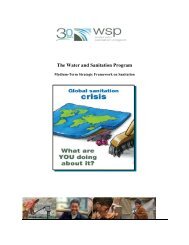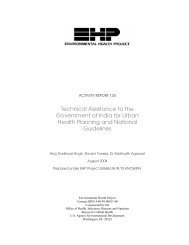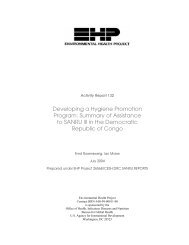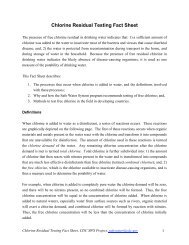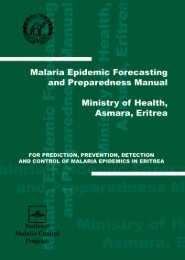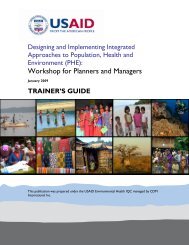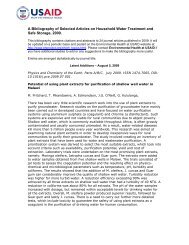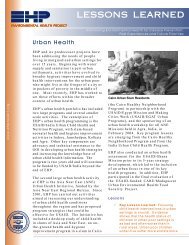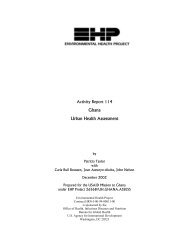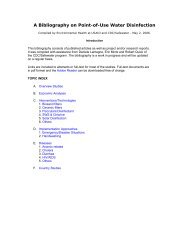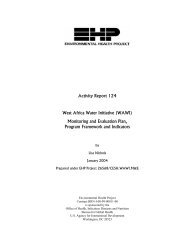Changing Glaciers and Hydrology in Asia - Environmental Health at ...
Changing Glaciers and Hydrology in Asia - Environmental Health at ...
Changing Glaciers and Hydrology in Asia - Environmental Health at ...
- No tags were found...
You also want an ePaper? Increase the reach of your titles
YUMPU automatically turns print PDFs into web optimized ePapers that Google loves.
focuses on research<strong>in</strong>g <strong>and</strong> monitor<strong>in</strong>g the potential ecosystem <strong>and</strong> human health impacts ofdevelopment activities such as adoption of <strong>in</strong>dustrial or agricultural technologies, <strong>and</strong> of clim<strong>at</strong>echange (particularly glacier melt/retre<strong>at</strong>). (This second type parallels the program approaches <strong>in</strong>Section 5.1 th<strong>at</strong> rel<strong>at</strong>e to research <strong>in</strong>to glaciers <strong>and</strong> associ<strong>at</strong>ed w<strong>at</strong>er systems.)Such programs could be implemented as new programs or modific<strong>at</strong>ions to new or ongo<strong>in</strong>gbiodiversity/n<strong>at</strong>ural resource management, food security <strong>and</strong> health programs th<strong>at</strong> would<strong>in</strong>corpor<strong>at</strong>e these elements <strong>and</strong> synergies.Good examples of human health issues th<strong>at</strong> would benefit from cause- r<strong>at</strong>her than symptomfocused,prevention-based Eco<strong>Health</strong> approaches are the diarrheal diseases th<strong>at</strong> result frompolluted w<strong>at</strong>er. The focus on ecosystems for health would <strong>in</strong>clude manag<strong>in</strong>g the sources ofpollution, provid<strong>in</strong>g safe dr<strong>in</strong>k<strong>in</strong>g w<strong>at</strong>er, <strong>and</strong> manag<strong>in</strong>g solid waste. Another example is shown <strong>in</strong>aspects of agricultural development (<strong>in</strong>secure l<strong>and</strong> tenure, lack of access to new cultivars,ta<strong>in</strong>ted livestock feed, excess pesticides) th<strong>at</strong> affect nutritional st<strong>at</strong>us.Sectors AddressedAlthough the focus is on <strong>in</strong>tegr<strong>at</strong><strong>in</strong>g health of humans <strong>and</strong> ecosystems, such programs alsoaddress biodiversity, agriculture, <strong>and</strong> w<strong>at</strong>er.Illustr<strong>at</strong>ive ProgramsIllustr<strong>at</strong>ive programs focus<strong>in</strong>g on ecosystems <strong>in</strong>clude the follow<strong>in</strong>g:621. At the n<strong>at</strong>ional level, <strong>in</strong>terventions <strong>in</strong>clude the promotion of policies th<strong>at</strong> focus onecosystem <strong>in</strong>tegrity <strong>and</strong> resilience. Such policies would promote l<strong>and</strong>scape-levelmapp<strong>in</strong>g, plann<strong>in</strong>g <strong>and</strong> management; habit<strong>at</strong> conserv<strong>at</strong>ion/management (pred<strong>at</strong>or-preyrel<strong>at</strong>ionships ma<strong>in</strong>ta<strong>in</strong>ed to avoid emergence of disease vectors; community-basedmanagement, with special <strong>at</strong>tention to local/<strong>in</strong>digenous knowledge); <strong>and</strong> the use ofn<strong>at</strong>ural regener<strong>at</strong>ion r<strong>at</strong>her than re-plant<strong>in</strong>g except on the most degraded sites withprerequisite local control of access to common property resources (community-basedn<strong>at</strong>ural resource management/governance).2. At the sub-n<strong>at</strong>ional level, work<strong>in</strong>g through regional authorities <strong>and</strong> local government,these ecosystem management activities could be <strong>in</strong>tegr<strong>at</strong>ed with w<strong>at</strong>er managementprograms such as streambank conserv<strong>at</strong>ion to prevent erosion <strong>and</strong> sediment<strong>at</strong>ion, floodpla<strong>in</strong> management, <strong>and</strong> improved groundw<strong>at</strong>er filtr<strong>at</strong>ion; <strong>and</strong> forest <strong>and</strong> rangel<strong>and</strong>conserv<strong>at</strong>ion/management with a focus on non-timber forest products th<strong>at</strong> directlycontribute to food security, particularly food, fruit, forage <strong>and</strong> medic<strong>in</strong>al plants.Interventions <strong>at</strong> this level should be aimed <strong>at</strong> improv<strong>in</strong>g the underst<strong>and</strong><strong>in</strong>g of theseissues, develop<strong>in</strong>g practical <strong>in</strong>terventions th<strong>at</strong> can be implemented <strong>in</strong> communities, <strong>and</strong>develop<strong>in</strong>g the capacity of regional <strong>and</strong> local <strong>in</strong>stitutions to plan <strong>and</strong> implement them.3. Applied research is also needed to develop a better underst<strong>and</strong><strong>in</strong>g of ecosystemmanagement for human health. This might <strong>in</strong>clude research aimed <strong>at</strong> an improvedunderst<strong>and</strong><strong>in</strong>g of the environmental, social, <strong>and</strong> economic <strong>in</strong>teractions associ<strong>at</strong>ed with



